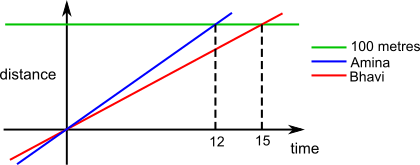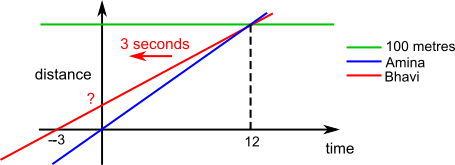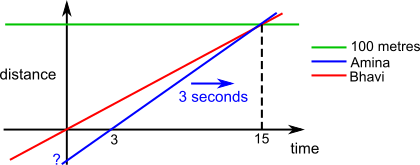Skip over navigation
Answer: a) 20 metres, b) 25 metres
Using ratio
a) If Amina runs 100 metres, then the race will be about 12 seconds long. Bhavi needs to run for about 12 seconds.
100 metres in 15 seconds
20 metres in 3 seconds
80 metres in 12 seconds
Head start of 20 metres.
b) If Bhavi runs 100 metres, then the race will be about 15 seconds long. Amina needs to run for about 15 seconds.
100 metres in 12 seconds
25 metres in 3 seconds
125 metres in 12 seconds
Start 25 metres behind Bhavi.
Using distance-time graphs
This distance-time graph shows the race if Amina and Bhavi both start at the same time.

a) The graph below shows the race if Bhavi starts in front of Amina

The time Bhavi takes is split into 12 and 3. Split the distance axis in the same way.
Share 100 metres in the ratio 12 : 3 = 4 : 1 = 80 : 20
Head start of 20 metres
b) The graph below shows the race if Amina starts behind Bhavi

Amina runs for 3 seconds before the start line and 12 seconds after the start line.
3 : 12 = ? : 100
1 : 4 = ? : 100
? = 25, start 25 metres behind


Or search by topic
Number and algebra
Geometry and measure
Probability and statistics
Working mathematically
Advanced mathematics
For younger learners
Leg It
Age 11 to 14
ShortChallenge Level 





- Problem
- Solutions
Answer: a) 20 metres, b) 25 metres
Using ratio
a) If Amina runs 100 metres, then the race will be about 12 seconds long. Bhavi needs to run for about 12 seconds.
100 metres in 15 seconds
20 metres in 3 seconds
80 metres in 12 seconds
Head start of 20 metres.
b) If Bhavi runs 100 metres, then the race will be about 15 seconds long. Amina needs to run for about 15 seconds.
100 metres in 12 seconds
25 metres in 3 seconds
125 metres in 12 seconds
Start 25 metres behind Bhavi.
Using distance-time graphs
This distance-time graph shows the race if Amina and Bhavi both start at the same time.

a) The graph below shows the race if Bhavi starts in front of Amina

The time Bhavi takes is split into 12 and 3. Split the distance axis in the same way.
Share 100 metres in the ratio 12 : 3 = 4 : 1 = 80 : 20
Head start of 20 metres
b) The graph below shows the race if Amina starts behind Bhavi

Amina runs for 3 seconds before the start line and 12 seconds after the start line.
3 : 12 = ? : 100
1 : 4 = ? : 100
? = 25, start 25 metres behind
You can find more short problems, arranged by curriculum topic, in our short problems collection.
You may also like
Consecutive Numbers
An investigation involving adding and subtracting sets of consecutive numbers. Lots to find out, lots to explore.
Days and Dates
Investigate how you can work out what day of the week your birthday will be on next year, and the year after...

